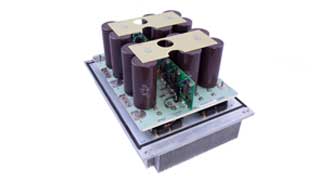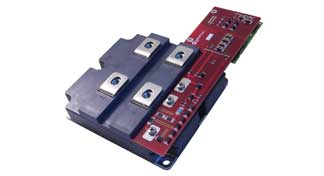This article is provided by the PSI Repair Team.
A cost clock starts ticking the moment a wind turbine stops working.

Will the OEM have the right spare parts when the turbine goes down? This and a few other things to consider when the turbine leave its warranty period.
Wind turbine efficiency is evaluated in terms of minutes (of production up or downtime) and dollars (spent on after-sales services as a result of system failure). As far as the bottom line is concerned, individual equipment failures and their root causes are moot points.
To maximize efficiency, the ideal wind farm would have in-house resources and know-how to conduct all necessary tests and repairs to restore turbines to full working order. To supplement these capabilities, the wind farm manager works hand-in-hand with OEMs of their turbine equipment to ensure fast turnaround and affordable replacement parts.
Economic realities make this scenario unrealistic for most wind farms. The manpower and financial resources associated with running a wind farm and operations and maintenance (O&M) team are cost-prohibitive.
Regarding OEMs, it’s important to remember that they are in the business of making and selling large quantities of the same products. If your defective part is under warranty, ordering a replacement from the OEM is typically a no-brainer. But, when component failure occurs off-warranty and you need immediate, cost-effective solutions, you should always consider a third-party independent service provider (ISP).
From a cost standpoint, purchasing replacement parts at full price from the OEM is exorbitantly expensive and unnecessary.You don’t have to break your bank to restore broken turbine equipment to like-new, working order.Wind farms can save millions every year by repairing rather than replacing defective components and by purchasing surplus and refurbished inventory.
As a rule of thumb, customers can expect to spend 40 to 70% less on repaired and surplus parts as opposed to new and/or replacement parts. For example, wind farm managers know that a particular replacement pitch system part costs around $5,000 from the OEM. However, when the component is outsourced to an ISP, it can be upgraded with newer technology—resulting in a part that runs cooler and lasts longer—for about 20 to 30% of the OEM replacement cost.
From a value and efficiency standpoint, ISPs are inherently geared toward providing high-quality customer service and technical solutions. In contrast to the OEM’s business model, standardized product design and sales don’t move their financial needle. Rather, these service-centric ISPs invest in engineering staff and advanced diagnostic equipment to help clients’ resolve production challenges, and their ROI is grounded in their success doing so. For this reason, parts repaired by ISPs often exceed the performance expectations and expected lifetime of new parts from the OEM.

The drop-in replacement inverter lets wind farms supplement their inventory with more reliable, longer-lasting technology while keeping turbines online. PSI also offers repair services for Xantrex Matrix Inverters from GE 1.5 MW S Series wind turbines.
Of course, not all ISPs are created equal. Finding a single contractor that can handle a wide range of preventative and corrective repair services (e.g. electronics, hydraulics, precision mechanical, etc.) isn’t easy. Even worse, shoddy craftsmanship and knock-off parts are major issues in certain corners of the aftermarket/repair industry.
While these concerns can discourage some companies from contracting ISPs, snuffing out rip-off repair shops and counterfeit parts isn’t rocket science. Here’s how you can do it in five minutes or less:
Use Google to your advantage. Run search queries for the company and scan for red flags on the one hand, and articles that establish their reputation as domain experts on the other. Do complaints or scam reports appear in the top search results? What about interviews or feature articles in various news/industrial publications? Do they have a LinkedIn company profile page, and are their employees listed? Can you find pictures of their facilities and testing equipment?
Then, take a critical look at the information on their website. How long have they been in business? If you plug their address into Google Maps / Street View, does everything appear to check out (i.e. approximate square footage and exterior photographs)? Do they provide case studies and press releases that detail specific examples and applications of repair work performed (Hint: if they don’t sound like pros, they probably are not.)?
Last but not least, what is the length of their typical warranty on services provided? If the ISP has confidence in their craftsmanship, they ought to offer superior warranties. Twelve-month warranties, for instance, offer assurances that the ISP can indeed make the part stronger than the original.
In addition to offering cost-cutting repair services and a wide inventory of refurbished parts, some ISPs deliver even greater value by looking beyond a single component repair job toward the greater picture: efficiency. To make an impact on a wind farm’s efficiency, it’s not enough to simply replace the part. ISPs can substantially increase wind farm efficiency as a whole by digging into the customer’s O&M processes and equipment and finding ways to root out unscheduled downtime and expenses.
 OEMs, by contrast, can only offer the bare minimum—at a premium price point—when it comes to dedicated, value-added customer service and engineering services. Understanding how an individual wind farm uses their equipment—and then determining (and eliminating) the root cause for failure—are capital expenditures that most OEMs won’t invest in.
OEMs, by contrast, can only offer the bare minimum—at a premium price point—when it comes to dedicated, value-added customer service and engineering services. Understanding how an individual wind farm uses their equipment—and then determining (and eliminating) the root cause for failure—are capital expenditures that most OEMs won’t invest in.
PSI Repair Services has been a trusted ISP to the wind energy market since 2008. We offer wind turbine component repair and upgrade services for GE, Vestas, Siemens, and Clipper turbines. We cover the critical electronic, hydraulic and precision mechanical components that drive your turbines’ pitch and yaw systems and down-tower electronics. Components we service include printed circuit boards, pitch drive systems (such as H-bridges and hub converters), IGBTs, PLCs, controls, AEBIs, proportional valves, pitch and yaw motors, encoders, slip rings, VRCC units, hydraulic pumps, servo motors, transducers and much more. Most of our services come with a 12-month warranty.
PSI has been in the repair business for almost 50 years, with customers belonging to the automotive, aerospace, defense and military, food and beverage, health care, public transportation, and semiconductor industries. Our state-of-the-art 60,000 square-foot facility in Livonia, Michigan is equipped with the most advanced diagnostic equipment in the industry.
Just recently, the company surpassed the 13,000 mark for components repaired or serviced for the wind industry. At an average repair price of $1,500, and a conservative 50% savings from the cost of new, PSI has saved the wind industry in the neighborhood of $10,000,000.
Customer savings aren’t merely a result of paying less for repairs, however. PSI’s world-class Engineering Services Department can accurately diagnose performance issues and offer permanent cost-saving solutions by recommending and taking preventive and corrective repair actions. These actions include: removing and replacing stressed parts; improving legacy design with newer, more reliable technology; remanufacturing unsalvageable or obsolete components; as well as manufacturing custom-designed products.
PSI Repair Services
http://www.psi-repair.com/repair-services/wind-turbine-parts-repair
Filed Under: News, O&M





After sales is very important for wind turbine system, and the maintenance cost is very high, development a long life slip ring is essential, but the maintenance is necessary.
if the wind turbine want to running normal, reliable data and power is very essential, especially for the data and communication cable, is is the connector between the control system with the turbine, because the special environment, the requires to the cable was very high, fiber optic and bus cable is a good choose. In additional, the wind turbine is the necessary parts in wind system.
More details: http://www.arslipring.com
Wind turbine OEMs are already using intellectual property rights (IPR) to exclude or drive up costs of independent service providers (ISPs) in the increasingly competitive wind services market.
The strength of the position the OEMs have on IPR ownership affords them significant negotiating leverage on long-term service agreements, specifically in restrictions on retrofits, re-manufacturing and third-party spares. Even for turbines which are off warranty, the patents held by some OEMs could preclude an ISP from performing service on the OEM’s turbines unless they are licensed and / or certified to do so.
This would be similar to how automotive vehicle manufacturers use special tools, which are patent protected, or hold copyrights on vehicle diagnostics codes so that independent repair shops must obtain the tools along with accredited certification to perform either in-warranty or even out-of-warranty service.
OEMs also tend to lock sub-component suppliers into supply contracts which preclude them from providing spares to ISPs or wind farm owners / operators directly. The OEMs now recognize this is an important revenue stream for them, particularly in a US market environment which has shifted revenue sources away from turbine sales towards services.
OEMs have patents on technologies such as SCADA and/or Condition Monitoring data analysis for damage accumulation, prediction of remaining useful life, predictive maintenance scheduling, spare parts scheduling, and energy output optimization taking component life consumption into consideration. Most ISPs do not bother to investigate infringement avoidance of these patents, yet perform service on turbines, potentially in violation of those intellectual property rights.
Owners / Operators do not realize the risk they run by contracting ISPs to perform this type of service work, because they do not obtain full indemnity from patent infringement liability in their supply agreements. They also need to be mandating full indemnity in an agreement with an ISP and should require the ISP to obtain an independent assessment of IPR infringement risks prior to engagement of services.
If the turbine OEMs start getting more assertive with their IPR, then ISPs and owners / operators could feel an extra squeeze. The net result of all this is likely to be higher costs for both OEM or third-party services and spares with turbine purchasers and owners / operators bearing the brunt of the cost. This cost ultimately gets passed onto utilities and then rate-payers, so consumers will feel the hit.
Unfortunately, in a market environment where the OEMs are trying to get more work in services to bolster their revenue drop-off from turbine sales, they do tend to get very aggressive with IPR when they feel like their revenue and / or market share is threatened.
The good news is that an independent assessment of IPR infringement risk may turn up certain limitations to the patents held by the OEMs and would put the negotiating leverage back in the hands of the owners / operators as well as the ISPs. This is likely a cheaper option than an ISP having to form a collaborative partnership with an OEM in order to be ‘certified’ to perform services on their turbines.